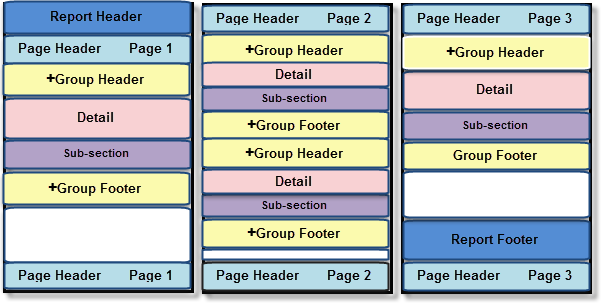Every report consists of the following five basic sections:
| Section | Description |
|---|---|
| Detail | The Detail section contains fields that are rendered once for each record in the source recordset. |
| Header | The Report Header section is rendered at the beginning of the report. |
| Footer | The Report Footer section is rendered at the end of the report. |
| Page Header | The Page Header section is rendered at the top of every page (except optionally for pages that contain the Report Header). |
| Page Footer | The Page Footer section is rendered at the bottom of every page. |
There are two additional sections for each group: a Group Header and a Group Footer Section. For example, a report with 3 grouping levels will have 11 sections.
An additional section, called Sub-section can also be added to any section of a report.
The following diagram shows how each section is rendered on a typical report. It also displays how a sub-section in the Detail section is rendered in the report:

Report Header
The first section rendered is the Report Header. This section usually contains information that identifies the report.
Page Header
After the Report Header comes the Page Header. If the report has no groups, this section usually contains labels that describe the fields in the Detail Section.
Group Headers and Group Footers
The next sections are the Group Headers, Detail, and Group Footers. These are the sections that contain the actual report data. Group Headers and Footers often contain aggregate functions such as group totals, percentages, maximum and minimum values, and so on. Group Headers and Footers are inserted whenever the value of the expression specified by the GroupBy property changes from one record to the next.
Detail
The Detail section contains data for each record. It is possible to hide this section by setting its Visible property to False, and display only Group Headers and Footers. This is a good way to create summary reports.
Page Footer
At the bottom of each page is the Page Footer Section. This section usually contains information such as the page number, total number of pages in the report, and/or the date on which the report was printed.
Report Footer
Finally, the Report Footer section is printed before the last page footer. This section is often used to display summary information about the entire report.
Sub-section
The sub-section can be added to any section of a report; by default it gets added at the bottom of the section that is currently selected. This section contains the additional data that enhances the data present in its parent section. A section’s height is determined by the sum of heights of its sub-sections.
Customized sections
You can determine whether or not a section is visible by setting its Visible property to True or False. Group Headers can be repeated at the top of every page (whether or not it is the beginning of a group) by setting their Repeat property to True. Page Headers and Footers can be removed from pages that contain the Report Header and Footer sections by setting the PageHeader and PageFooter properties on the Layout object.